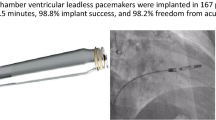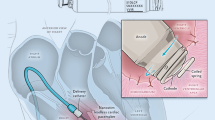Abstract
Theoretically, replacement of a VDD device requires using a similar pacemaker to provide the best match between the filtering characteristics of the pacemaker and the atrial dipole of the lead. This study evaluated the performance of newly implanted Vitatron VDD pacemakers connected to dedicated leads and compared the results with those of the same Vitatron pacemakers used as replacement but connected to a variety of nondedicated leads.
Methods: 23 consecutive patients (15 M, 8 F, 78 ± 6 years) in Group 1 underwent pacemaker replacement with a VDD(R) Saphir 3 (Vitatron BV, Arnhem, The Netherlands) device designed for an 8.6 mm atrial dipole. Atrial dipoles of the previously implanted leads ranged from 5 to 30 mm. Another 22 consecutive patients (14 M, 8 F, 80 ± 7 years) in Group 2 received a Saphir 3 pacemaker with the related dedicated lead.
Results: P-wave amplitude measured by the same Pacing Sensing Analyzer (PSA) at the first implantation was 1.7 ± 0.8 vs. 1.7 ± 0.5 mV (P = NS) in groups 1 and 2 respectively. P-wave amplitudes measured at 1 month follow-up after replacement in Group 1 and at 1 month follow-up after implantation in Group 2 were 0.69 ± 0.5 vs. 0.85 ± 0.3 mV (P = NS) respectively. The percentage of atrial sensing at the same follow-up was 97 ± 3 vs. 95 ± 5% (P = NS) in groups 1 and 2 respectively.
Conclusions: Replacement of VDD pacemakers with the Saphir 3 model designed for a short dipole is safe and reliable when used in combination with previously implanted nondedicated leads.
Similar content being viewed by others
References
Gregoratos G, Abrams J, Epstein AE, Freedman RA, Hayes DL, Hlatky MA, Kerber RE, Naccarelli GV, Schoenfeld MH, Silka MJ, Winters SL, Gibbons RJ, Antman EM, Alpert JS, Gregoratos G, Hiratzka LF, Faxon DP, Jacobs AK, Fuster V, Smith SC Jr; American College of Cardiology/American Heart Association Task Force on Practice Guidelines/North American Society for Pacing and Electrophysiology Committee to Update the 1998 Pacemaker Guidelines. ACC/AHA/NASPE 2002 guideline update for implantation of cardiac pacemakers and antiarrhythmic devices: A report of the ACC/AHA Task lowercaseForce on Practice Guidelines (ACC/AHA/NASPE Committee on Pacemaker Implantation). 2002 by the American College of Cardiology Foundation and the American Heart Association, Inc. http://www.acc.org; http://www.americanheart.org; http://www.naspe.org.
Antonioli GE. Single lead atrial synchronous ventricular pacing: A dream come true. Pacing Clin Electrophysiol 1994;17: 1531–1547.
Wiegand UKH, Bode F, Schneider R, Taubert G, Brandes A, Peters W, Katus HA, Potratz J. Atrial sensing and AV synchrony in single lead VDD pacemakers: A prospective comparison to DDD devices with bipolar atrial leads. J Cardiovasc Electrophysiol 1999;10:513–520.
Wiegand UKH, Bode F, Schneider R, Brandes A, Haase H, Katus HA, Potratz J. Development of sinus node disease in patients with AV block: Implications for single lead VDD pacing. Heart 1999;81:580–585.
Brownlee RR. Toward optimizing the detection of atrial depolarization with floating bipolar electrodes. Pacing Clin Electrophysiol 1989;12:431–442.
Antonioli GE, Audoglio R, Brownlee RR. Science, theory, and clinical considerations related to sensing atrial depolarization in single-lead pacing. In: GE Antonioli AE Aubert and H Ector (eds.), Pacemaker Leads. Elsevier. 1991:115–133.
Antonioli GE, Audoglio R. Single lead pacing. Do we have the right lead? In: GE Antonioli (ed.), Pacemaker Leads. Monduzzi. 1997:119–127.
Barbieri D, Ansani L, Guardigli G, Percoco GF, Toselli T, Antonioli GE. High-resolution and frequency content analysis of floating endo-atrial signal at different dipole lengths. In: GE Antonioli AE Aubert and H Ector (eds.), Pacemaker Leads. Elsevier. 1991:135–141.
Silvestri L, Masini M, Renesto F, Vaccarone L. Optimizing sensing amplifier design in VDD single lead pacers. EUR.J.C.P.E., Vol 6, N.1, June 1996, Supplement 5, 965 (153/1), abstract.
Boute W, Albers BA, Giele V. Avoiding atrial undersensing by assessment of P wave amplitude histogram data. Pacing Clin Electrophysiol 1994;17(Pt II):1878–1882.
Ansani L, Percoco GF, Guardigli G, Toselli T, Antonioli GE. Long-term reliability of single-lead atrial synchronous pacing systems using closely spaced atrial dipoles: Five-year experience. Pacing Clin Electrophysiol 1994;17(Pt II):1865– 1869.
Wiegand UHK, Nowak B, Reisp, Peiffer T, Bode F, Potratz J. Implantation strategy of the atrial dipole impacts atrial sensing performance of single lead VDD pacemakers. Pacing Clin Electrophysiol 2002;25:316–323.
Toivonen L, Lommi J. Dependence of atrial sensing function on posture in a single-lead atrial triggered ventricular (VDD) pacemaker. Pacing Clin Electrophysiol 1996;19:309–313.
Chiladakis JA, Patsouras N, Agelopoulos G, Nikolopoulos N, Manolis AS. Comparative three-year performance of chronic atrial sensing among eight different VDD systems. Am J Cardiol 2002;89:1215–1218.
Santini M, Ricci R, Pignalberi C, Brandes A, Haase H, Katus HA, Potratz J. Immediate and long-term atrial sensing stability in single-lead VDD pacing depends on right atrial dimensions. Europace 2001;3:324–331.
Ovsycher IE, Crystal E. VDD pacing: Under-evaluated, under-valued and under-used. Pacing Clin Electrophysiol 2004;27:1335–1338.
Parsonnet V, Myers GH, Kresh YM. Characteristics of intracardiac electrograms II: Atrial endocardial electrograms. Pacing Clin Electrophysiol 1980;3:406–417.
Aubert AE, Ector H, Denys BG, De Geest H. Sensing characteristics of unipolar and bipolar orthogonal floating atrial electrodes: Morphology and spectral analysis. Pacing Clin Electrophysiol 1986;9:343–359.
Author information
Authors and Affiliations
Rights and permissions
About this article
Cite this article
Fabiani, A., Burali, A., Manfredini, E. et al. VDD pacemaker replacement is safe and reliable independently of the previously implanted lead: A prospective and controlled study. J Interv Card Electrophysiol 15, 107–111 (2006). https://doi.org/10.1007/s10840-006-7743-3
Received:
Accepted:
Issue Date:
DOI: https://doi.org/10.1007/s10840-006-7743-3




